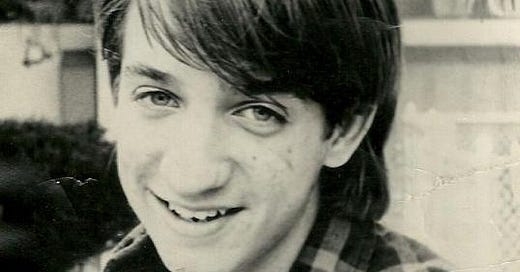Remember What It’s Like to Be a Kid
Reflections on adolescence, emotional memory, and the latest chapter of Breaking Character
Good morning and happy Saturday!
For reasons I don’t fully understand, I’ve always had a vivid memory of what it felt like to be a kid. Not just the major milestones, but the raw emotional truth of being in fifth grade, eighth grade, or a junior in high school. It’s all still in there—clear, distinct…
And occasionally overwhelming.
I draw on those memories/feelings a lot in my writing. In theater, we call it emotional memory—the ability to revisit past feelings and infuse them into your performance or your words. It’s a powerful tool, and it’s how I try to bring authenticity to my characters, especially when I’m writing from a young adult perspective.
This morning I wrote a new chapter for Breaking Character, and it left me thinking about just how complicated being a teenager really is.
In this chapter, my protagonist Cassie is finally trying to apologize for a mistake she made over a year and a half ago—when she was just 13. The kind of mistake that feels catastrophic at that age. The kind that ends friendships.
Cassie betrayed an unspoken trust between her and her best friend Jesse. Not intentionally—far from it. In fact, she was hurting on Jesse’s behalf and made the mistake of confiding in the wrong person. That person is the one who did the real damage. But Jesse didn’t see it that way. From his point of view, Cassie crossed a line that couldn’t be uncrossed.
And so the friendship ended.
Now, Jesse does shoulder some responsibility for how he responded—and the story will eventually address that. But in this moment, early in the narrative, Cassie feels the full weight of the blame. And for the first time on the page, she takes ownership of it. She steps up. She’s trying to make things right.
Her motivation?
Lindsay, their mutual best friend, is in the hospital after a serious car accident. And Cassie knows that if she and Jesse can find a way to heal, they might be able to show up for Lindsay in a meaningful way.
That age—11, 12, 13—is when the world starts to shift. It’s no longer black and white. The innocence of elementary school gives way to complexity, contradictions, and hard lessons about human behavior.
Even with the most empathetic adults around, there are things you simply have to go through.
I see that now in my own home. I see it when my teenager is hurting, when something unfair happens, when someone acts cruelly. And sometimes the only thing I can say is: “You're right. That was wrong. Those people were assholes. And I’m so sorry. I wish I could fix it. But some of this, you just have to walk through. And we’ll be here every step of the way.”
As a parent, that’s gutting.
But as a writer, I can hold that pain and channel it. I can go back to what it felt like and give it shape on the page. Because some things don’t change. The circumstances might shift, the slang might evolve, but the heart of adolescence—the turbulence, the tenderness, the emotional stakes—that stays the same.
That’s why I write this kind of story.
Whether my books are labeled as “young adult” or not, I’m always writing in that voice. Not because I think only teens will read it, but because I want to honor the intensity and authenticity of that age. I want to reflect it back with compassion and clarity.
When Cassie makes her apology, she’s doing something brave. Her mistake wasn’t earth-shattering by adult standards, but to a 13-year-old, it was massive. And what matters is that she’s choosing to take responsibility. She’s showing agency. She’s trying to repair something that was broken.
That’s admirable. That’s worth writing about. That’s worth emulating.
The next chapter I’ll be writing is one I’m excited about—Cassie going to the hospital to see Lindsay for the first time since the accident. They haven’t spoken in over a year. It’s a pivotal moment, the rekindling of a friendship. I think it’s going to be emotional and joyful.
We don’t get to rewrite the past in real life. But in fiction, we can show what redemption looks like. We can show characters making brave choices and reaching across divides. We can illustrate the possibilities.
And yeah, there’s conflict. There’s betrayal. There’s heartbreak. But if we do it right, there’s also warmth and hope and second chances.
That’s the journey Cassie is on. And I hope readers of all ages see themselves in it.
Thanks for following along with Breaking Character. It’s moving forward (maybe not as fast as I’d like, but I’m juggling a lot of projects—and I should probably stop reading the news). The next step will likely be a Kickstarter launch, so keep an eye out.
In the meantime, I hope your weekend includes something joyful. Something peaceful. Something mindful.
Take care, keep reading,
~ Tom




